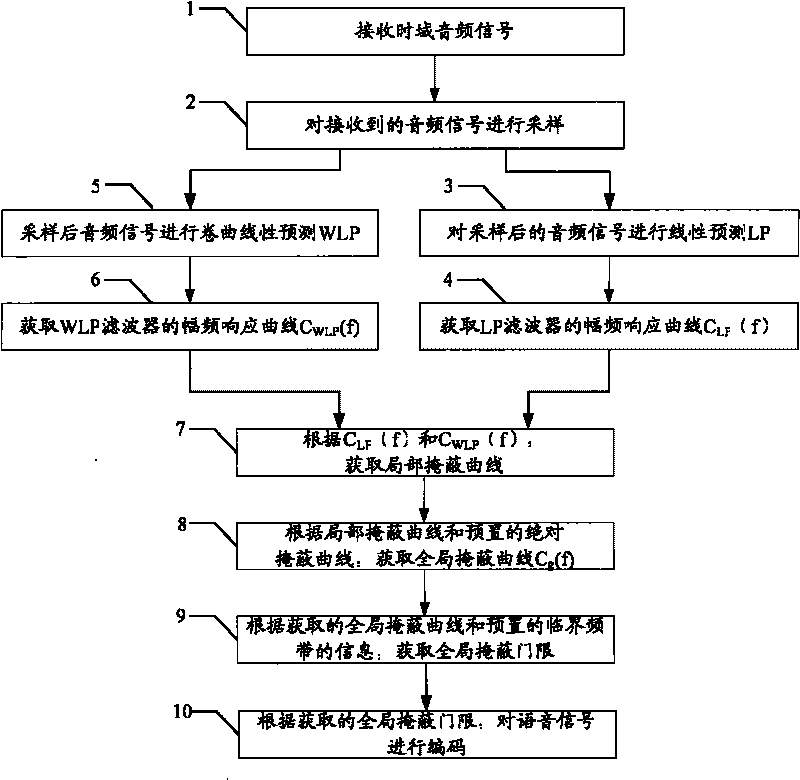Audio coding method and audio coder
An audio coding and audio signal technology, which is applied in the field of audio coding and decoding, can solve the problems of high hardware equipment requirements, high power consumption, and difficult implementation, and achieve the effects of reducing complexity, reducing power consumption, and being easy to implement
- Summary
- Abstract
- Description
- Claims
- Application Information
AI Technical Summary
Problems solved by technology
Method used
Image
Examples
Embodiment 1
[0057] The present embodiment provides a kind of audio coding method, and this method is to utilize the frequency resolution characteristic of warped linear prediction (WLP, Warped Linear Prediction) and traditional linear prediction (LP, Linear Prediction) analysis to be very close to the critical frequency band in the human auditory characteristic and the characteristics of the masking feature, and finally obtain the masking threshold. see figure 2 As shown, the method includes:
[0058] Step 1: The encoder receives the time-domain audio signal;
[0059] The time-domain audio signal received by the encoder can be a speech signal, an audio signal, or a mixture of various sound signals that can be heard by the human ear. The frequency bandwidth of the audio signal is usually within the frequency range that can be heard by the human ear (ie 0Hz to 24000Hz). The audio signal received by the encoder is usually in a frame format, and the length of a frame is generally between ...
Embodiment 2
[0134] The embodiment of the present invention provides an audio coding method, see Figure 9 , and refer to the audio encoder shown in FIG. 1 . The method for obtaining the global masking threshold of the psychoacoustic model in the audio coding method utilizes a method for establishing a psychoacoustic model provided in Embodiment 1. An embodiment of the present invention provides an audio coding method including:
[0135] Step H1: the encoder receives a time-domain audio signal;
[0136] Wherein, the time-domain audio signal received by the encoder is the same step as that performed in step 1 in the first embodiment.
[0137] Step H2: The encoder establishes a psychoacoustic model based on the received time-domain audio signal to obtain a global masking threshold;
[0138] Wherein, for the execution method of step H3, reference may be made to the description in Embodiment 1.
[0139] Step H3: The encoder encodes the received time-domain audio signal according to the glo...
Embodiment 3
[0143] This embodiment provides an audio encoder, see Figure 10 As shown, it includes: receiving unit 10, sampling unit 20, linear prediction LP unit 30, obtaining LP filter amplitude-frequency response unit 40, curl linear prediction WLP unit 50, obtaining WLP filter amplitude-frequency response unit 60, obtaining local masking curve A unit 70 is configured to obtain a global masking curve unit 80 , a masking threshold unit 90 and an audio encoding unit 100 .
[0144] Wherein, the receiving unit 10 receives a time-domain audio signal, and the received time-domain audio signal may be a speech signal, an audio signal, or mixed information of various sound signals that can be heard by various human ears, and the frequency bandwidth of the audio signal is generally Since the human ear can hear the frequency range (ie 0 Hz to 24000 Hz), the audio signal is usually in a frame format, and the length of a frame is generally between 5 milliseconds and 30 milliseconds.
[0145] The a...
PUM
 Login to View More
Login to View More Abstract
Description
Claims
Application Information
 Login to View More
Login to View More - R&D
- Intellectual Property
- Life Sciences
- Materials
- Tech Scout
- Unparalleled Data Quality
- Higher Quality Content
- 60% Fewer Hallucinations
Browse by: Latest US Patents, China's latest patents, Technical Efficacy Thesaurus, Application Domain, Technology Topic, Popular Technical Reports.
© 2025 PatSnap. All rights reserved.Legal|Privacy policy|Modern Slavery Act Transparency Statement|Sitemap|About US| Contact US: help@patsnap.com



